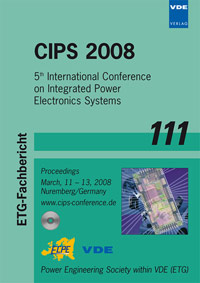Duplex pulse controlled inverter with a film capacitor DC-link
Conference: CIPS 2008 - 5th International Conference on Integrated Power Electronics Systems
03/11/2008 - 03/13/2008 at Nuremberg, Germany
Proceedings: CIPS 2008
Pages: 5Language: englishTyp: PDF
Personal VDE Members are entitled to a 10% discount on this title
Authors:
Kleimaier, A.; Hoffmann, B.; Scherer, A. (Compact Dynamics GmbH, Moosstrasse 9, D-82319 Starnberg, Germany)
Abstract:
New concepts of compact, high-power and high-efficiency electric drives for automotive applications result in high demands on the integrated power electronics. The DC voltage link of pulse-controlled motor inverters is typically provided with an electrolytic capacitor bank – nevertheless there are significant disadvantages concerning required space, limited current and temperature as well as the ESR and the parasitic series inductance. This article presents a new approach with a very compact DC link exclusively realized with film capacitors. To minimize the DC-voltage ripple, the inverter is split into two 3-phase systems providing an electric motor with windings segmented accordingly. The PWM of the second system has an offset of 90 degrees PWM clock cycle. Comparative measurements with reference to a conventional inverter with electrolytic capacitors show a clear advantage at the high frequency pulse ripple. On the other hand, the capacitance which can be realized by film capacitors is about 20 times lower (when rated with a comparable required space), so this has to be paid with more ripple of the DC voltage at the low frequency range, e.g. generated by asymmetrical load currents or the operation of superposed control loops of the current controller. This may be a disadvantage for converters driving high dynamic actuators or servo-motors, but no problem for electric drives with functions in the automotive energy management (e.g. new forms of alternators) or in the drive train (hybrid motors).


